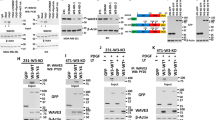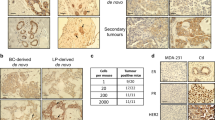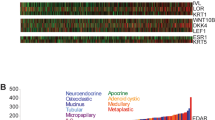Abstract
A high proportion of human breast cancers, in contrast with normal mammary tissue, express the intracellular tyrosine kinase BRK. BRK expression enhances the mitogenic response of mammary epithelial cells to epidermal growth factor, and conferment of a proliferative advantage through this mechanism may account for the frequent elevation of BRK expression in tumours. Here we report that BRK expression in mammary epithelial cells, at pathologically relevant levels, results in an enhanced phosphorylation of the epidermal growth factor receptor-related receptor erbB3 in response to epidermal growth factor. As a consequence, erbB3 recruits increased levels of phosphoinositide 3-kinase, and this is associated with a potentiated activation of Akt. This effect of BRK on the regulation of phosphoinositide 3-kinase and Akt activity may account for BRK's ability to enhance mammary cell mitogenesis, and raises the possibility that breast tumours expressing BRK may acquire a resistance to pro-apoptotic signals.
This is a preview of subscription content, access via your institution
Access options
Subscribe to this journal
Receive 50 print issues and online access
$259.00 per year
only $5.18 per issue
Buy this article
- Purchase on Springer Link
- Instant access to full article PDF
Prices may be subject to local taxes which are calculated during checkout




Similar content being viewed by others
References
Balendran A, Casamayor A, Deak M, Paterson A, Gaffney P, Currie R, Downes CP and Alessi DR. . 1999 Curr. Biol. 9: 393–404.
Barker KT, Jackson LE and Crompton MR. . 1997 Oncogene 15: 799–805.
Datta SR, Brunet A and Greenberg ME. . 1999 Genes Dev. 13: 2905–2927.
Di Cristofano A and Pandolfi PP. . 2000 Cell 100: 387–390.
Dufourny B, Alblas J, van Teeffelen HA, van Schaik FM, van der Burg B, Steenbergh PH and Sussenbach JS. . 1997 J. Biol. Chem. 272: 31163–31171.
Fedi P, Pierce JH, di Fiore PP and Kraus MH. . 1994 Mol. Cell. Biol. 14: 492–500.
Graus-Porta D, Beerli RR, Daly JM and Hynes NE. . 1997 EMBO J. 16: 1647–1655.
Guy PM, Platko JV, Cantley LC, Cerione RA and Carraway KL 3rd. . 1994 Proc. Natl. Acad. Sci. USA 91: 8132–8136.
Kamalati T, Jolin HE, Mitchell PJ, Barker KT, Jackson LE, Dean CJ, Page MJ, Gusterson BA and Crompton MR. . 1996 J. Biol. Chem. 271: 30956–30963.
Kandel ES and Hay N. . 1999 Exp. Cell Res. 253: 210–229.
Kim HH, Sierke SL and Koland JG. . 1994 J. Biol. Chem. 269: 24747–24755.
Kim H and Muller WJ. . 1999 Exp. Cell Res. 253: 78–87.
Kolibaba KS and Druker BJ. . 1997 Biochim. Biophys. Acta 1333: F217–F248.
Lee H, Kim M, Lee KH, Kang KN and Lee ST. . 1998 Mol. Cells 8: 401–407.
Llor X, Serfas MS, Bie W, Vasioukhin V, Polonskaia M, Derry J, Abbott CM and Tyner AL. . 1999 Clin. Cancer Res. 5: 1767–1777.
Mitchell PJ, Barker KT, Martindale JE, Kamalati T, Lowe PN, Page MJ, Gusterson BA and Crompton MR. . 1994 Oncogene 9: 2383–2390.
Mitchell PJ, Barker KT, Shipley J and Crompton MR. . 1997 Oncogene 15: 1497–1502.
Prigent SA and Gullick WJ. . 1994 EMBO J. 13: 2831–2841.
Rameh LE and Cantley LC. . 1999 J. Biol. Chem. 274: 8347–8350.
Riese II DJ and Stern DF. . 1998 Bioessays 20: 41–48.
Soltoff SP, Carraway III KL, Prigent SA, Gullick WG and Cantley LC. . 1994 Mol. Cell Biol. 14: 3550–3558.
Stamps AC, Davies SC, Burman J and O'Hare MJ. . 1994 Int. J. Cancer 57: 865–874.
Toker A and Newton AC. . 2000 J. Biol. Chem. 275: 8271–8274.
Vanhaesebroeck B and Waterfield MD. . 1999 Exp. Cell Res. 253: 239–254.
Vasioukhin V, Serfas MS, Siyanova EY, Polonskaia M, Costigan VJ, Liu B, Thomason A and Tyner AL. . 1995 Oncogene 10: 349–357.
Vasioukhin V and Tyner AL. . 1997 Proc. Natl. Acad. Sci. USA 94: 14477–14482.
Whitman M, Kaplan DR, Schaffhausen B, Cantley L and Roberts TM. . 1995 Nature 315: 239–242.
Zimmerman S and Moelling K. . 1999 Science 286: 1741–1744.
Acknowledgements
The authors thank Dr Ian Hiles (GlaxoWellcome, Stevenage, UK) for the gift of the human erbB3 cDNA.MR Crompton is supported by a research grant from the School of Biological Sciences, Royal Holloway, University of London. MJ Fry is supported by a research grant from the School of Animal and Microbial Sciences, University of Reading. This research was initiated in the Section of Cell Biology and Experimental Pathology, Institute of Cancer Research, Sutton, Surrey, UK with research support from GlaxoWellcome plc. (MR Crompton, T Kamalati, HE Jolin) and the Leopold Muller Trust (MJ Fry).
Author information
Authors and Affiliations
Rights and permissions
About this article
Cite this article
Kamalati, T., Jolin, H., Fry, M. et al. Expression of the BRK tyrosine kinase in mammary epithelial cells enhances the coupling of EGF signalling to PI 3-kinase and Akt, via erbB3 phosphorylation. Oncogene 19, 5471–5476 (2000). https://doi.org/10.1038/sj.onc.1203931
Received:
Revised:
Accepted:
Published:
Issue Date:
DOI: https://doi.org/10.1038/sj.onc.1203931
Keywords
This article is cited by
-
Prognostic impact of PTK6 expression in triple negative breast cancer
BMC Women's Health (2023)
-
Estrogen receptor signaling regulates the expression of the breast tumor kinase in breast cancer cells
BMC Cancer (2019)
-
The expression and prognostic value of protein tyrosine kinase 6 in early-stage cervical squamous cell cancer
Chinese Journal of Cancer (2016)
-
Low expression of PTK6/Brk predicts poor prognosis in patients with laryngeal squamous cell carcinoma
Journal of Translational Medicine (2013)
-
Protein tyrosine kinase 6 regulates mammary gland tumorigenesis in mouse models
Oncogenesis (2013)



